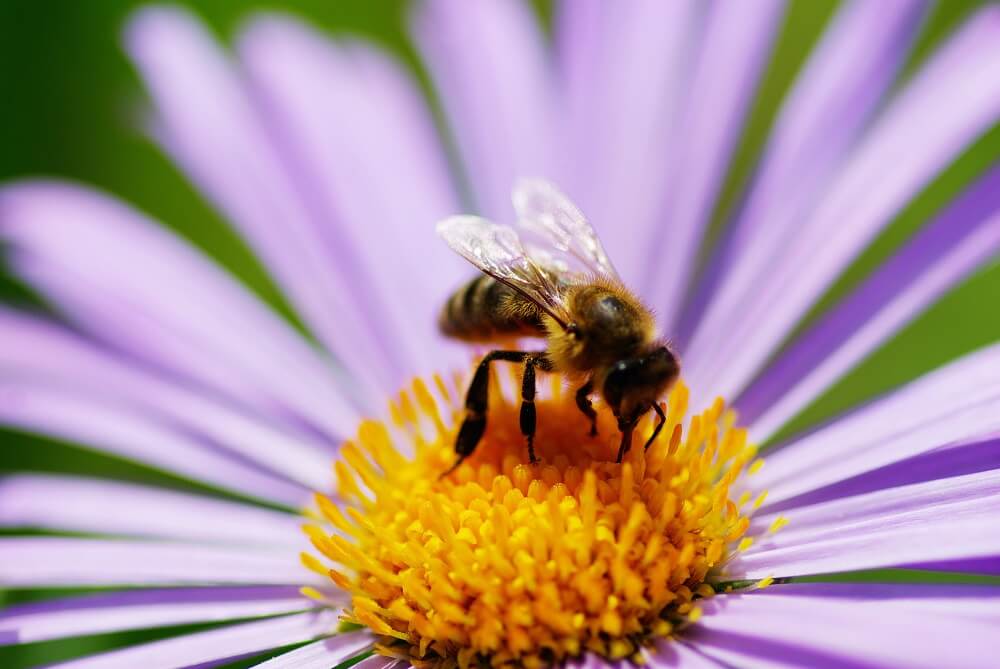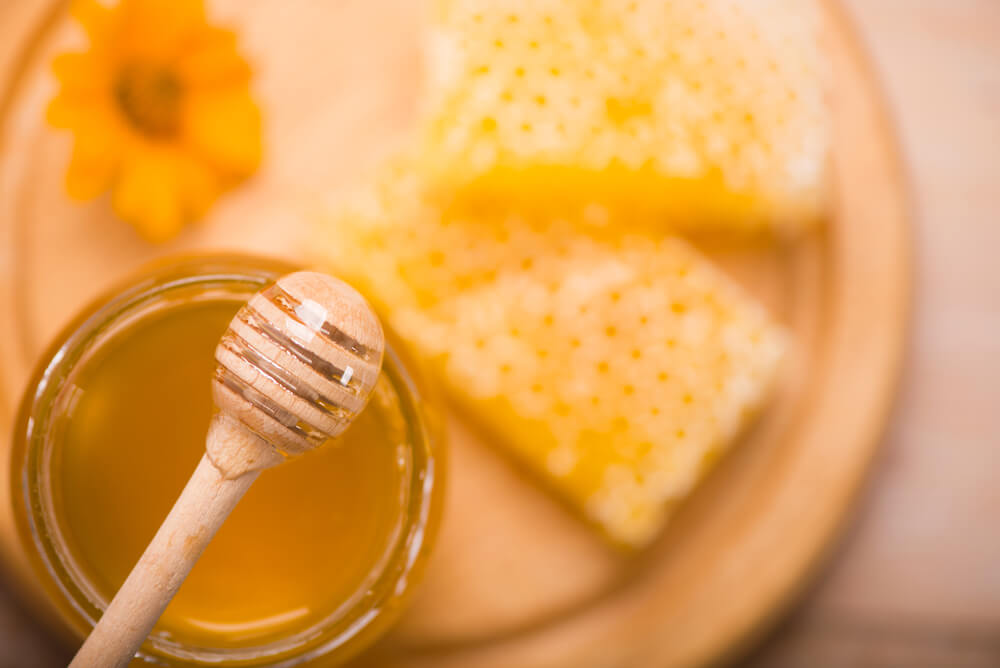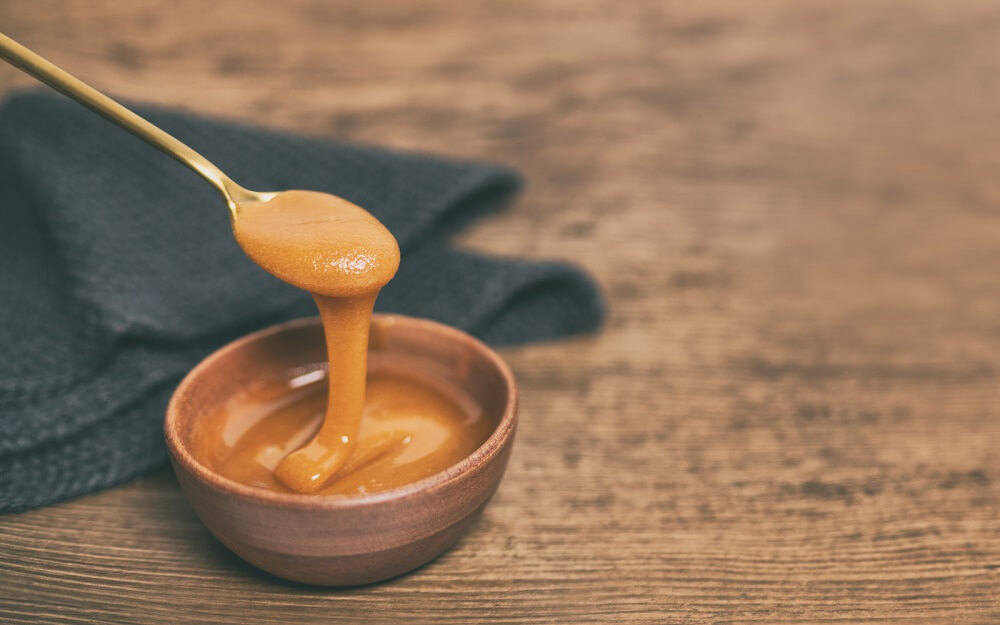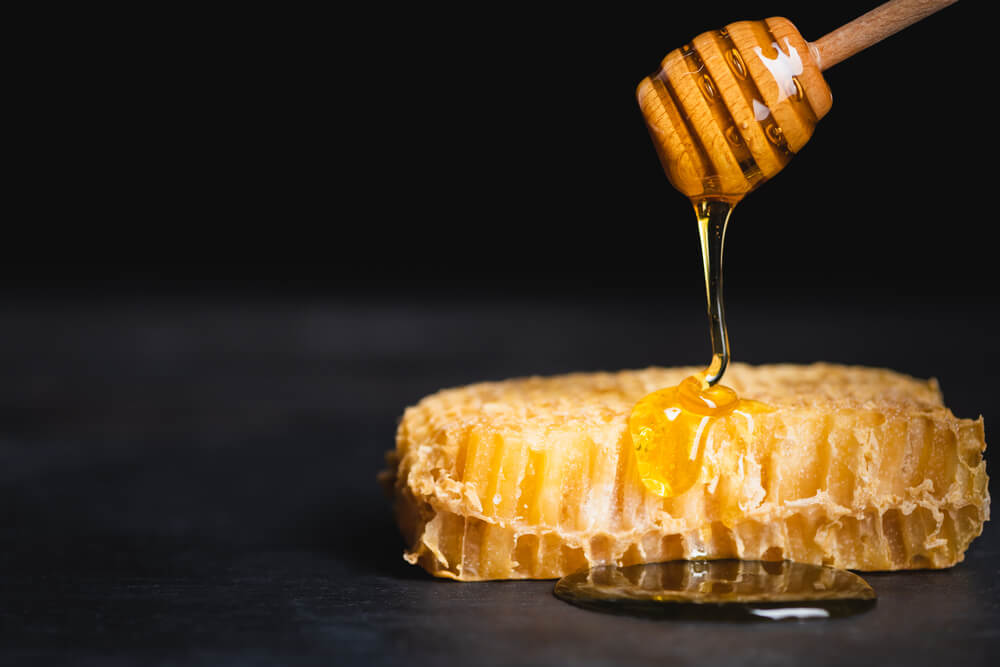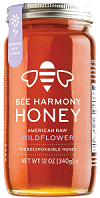Table of Contents:
What is Wildflower Honey?
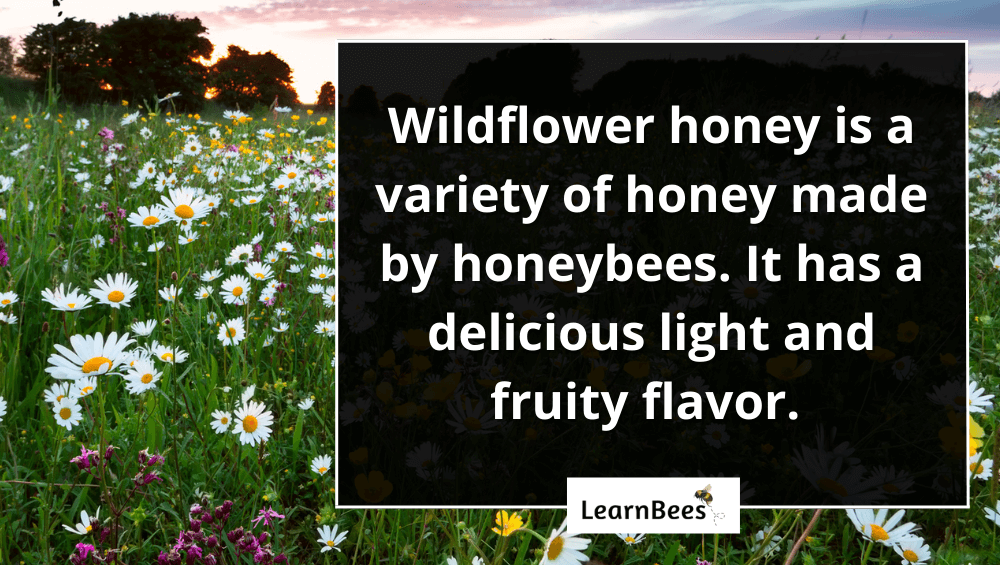
Wildflower honey is a variety of honey made by honeybees.
And as the name suggests?
Honeybees make this type of honey by collecting nectar from wildflowers. A wildflower is a plant that grows naturally without being intentionally planted.(1)
But now that brings us to the million-dollar question:
What does wildflower honey taste like?
Most wildflower honey comes with some form of a light, fruity flavor. Once you taste your first spoonful of it, you’ll never go back to the store-bought stuff.
But I’ll shoot straight with you:
No two jars of wildflower honey will taste the same. There are more than 6,000 wildflower species in the US alone. So wildflower honey from the hills of Mississippi will taste entirely different from that of California.(2)
What are the Wildflower Honey Benefits?
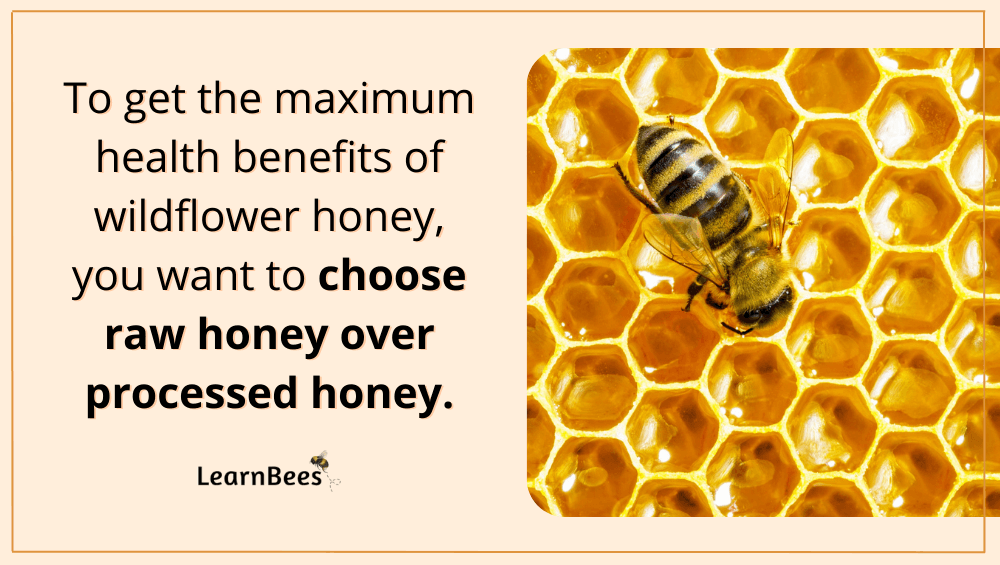
Let me issue a disclaimer:
To get the maximum health benefits of honey, you want to choose raw wildflower honey over processed wildflower honey.
Why?
Because processed honey often gets stripped of its health benefits during the pasteurization process. More specifically, the heating and filtering process removes antioxidants and minerals from honey.(3, 4, 5)
To add insult to injury?
Processed honey often comes with artificial sweeteners like sugar or high fructose corn syrup. This means it’s no longer considered real honey, according to the FDA.(6)
So, in summary:
Choose raw wildflower honey over the processed stuff.
Wildflower Honey Nutrition
One tablespoon (21 grams) of wildflower honey contains:
- Calories: 60 calories
- Protein: 0 grams
- Fat: 0 grams
- Carbs: 17 grams
This type of honey is mostly carbohydrates in the form of natural sugars. It also has some vitamins and minerals, including magnesium, potassium, iron, and zinc.(7)
How does this translate into health benefits?
Let’s talk about that next.
Benefit 1: Honey Can Soothe a Stubborn Cough
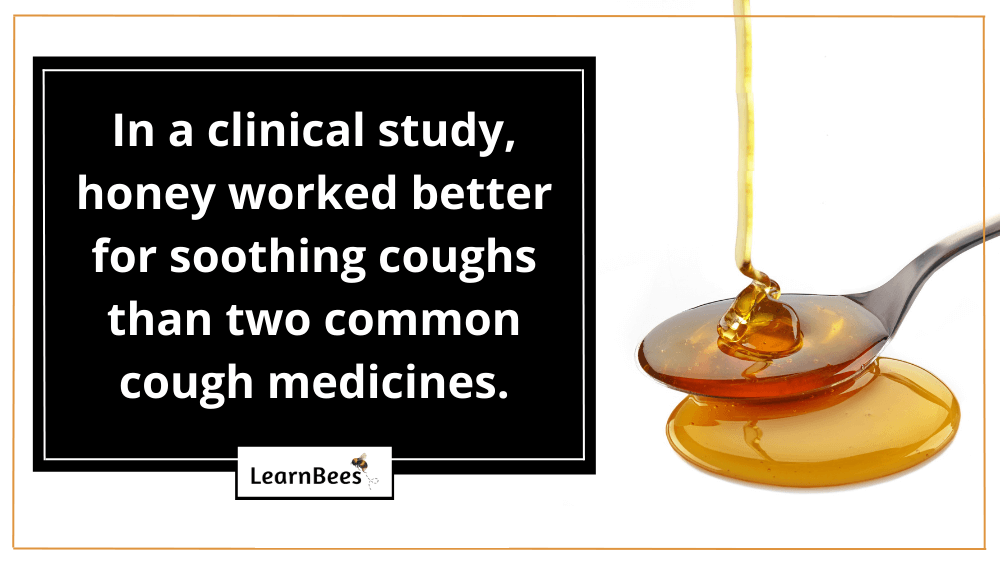
You know that aggravating cough you get with upper respiratory infections? That cough that keeps you up at night because it just won’t go away?
Honey can help with that.
In fact, a clinical study of 139 children found that honey worked better for soothing coughs than two common cough medicines did. Another study found that honey decreased cough symptoms and improved sleep more than cough medication.(8, 9)
More importantly?
Some cough medications come with side effects. So overall, honey is a better choice than some cough medications.(10, 11)
That’s why I make sure to have a jar of raw and unfiltered honey on hand during cold and flu season.
Benefit 2: Honey is Good For Your Skin
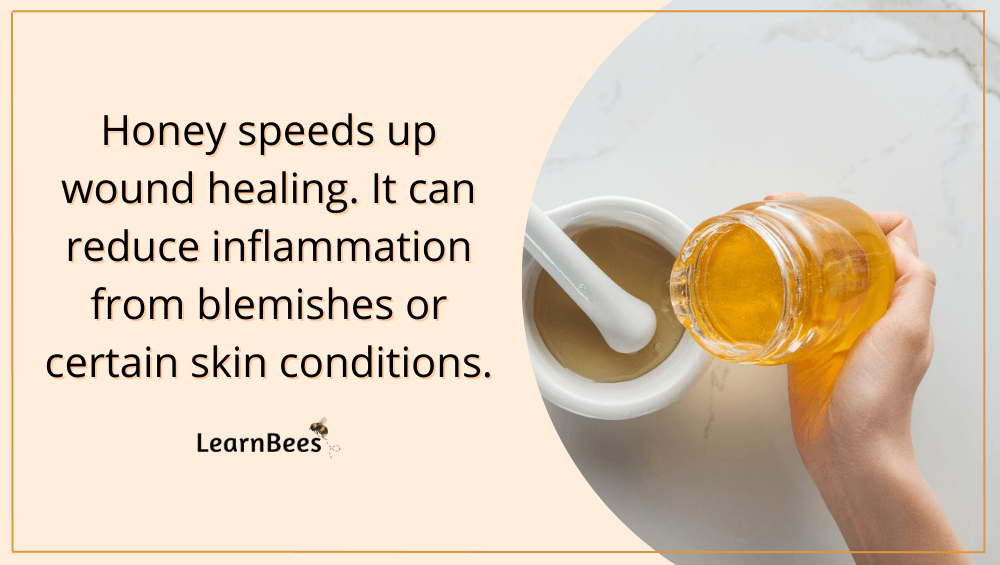
If you walk down any skincare aisle, you’ll see honey in moisturizers, face washes, eye creams, and so on. Even entire brands like Burt’s Bees are dedicated to making beeswax and honey products.
That’s no coincidence.
For starters, raw honey helps balance bacteria on your skin, making it an excellent product for acne. In some cases, honey is significantly more effective in fighting acne than other popular products.(12, 13, 14)
Secondly, honey is beneficial for people with skin conditions like eczema or psoriasis.
Why?
Because it speeds up your skin’s healing process. And if you have an eczema outbreak or blemishes, raw honey can help reduce inflammation.(15, 16)
Doctors have even started recommending honey in clinical settings to heal wounds. The antibacterial properties of honey make it a good choice for burns and scratches.(17, 18, 19)
And last but not least?
Honey has shown to be a promising treatment against dandruff, diaper rash, psoriasis, hemorrhoids, and anal fissure.(20)
Benefit 3: Honey is Rich in Antioxidants
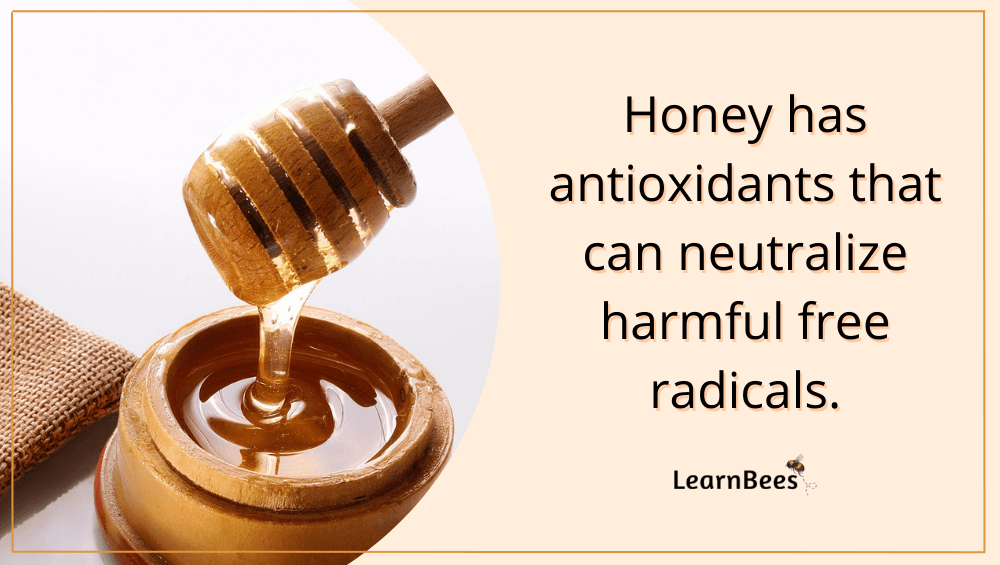
Let’s face it.
We hear a lot about antioxidants, but do we really understand why they’re essential?
Let me break it down for you.
Your body needs antioxidants to keep free radicals in check. Free radicals are unstable atoms that can damage your cells. If your free radical levels become too high, it can put you at risk for cancer, diabetes, and multiple types of diseases.(21, 22, 23)
This is where antioxidants come in. They help neutralize these free radicals so they can’t harm your cells.
Honey has been known to help the arteries in your heart dilate, increasing blood flow to your heart. Honey can also help prevent blood clots that lead to heart attacks and strokes.(24)
But that’s only the beginning. Honey has numerous heart benefits, so let’s talk about those next.
Benefit 4: Honey Promotes Heart Health
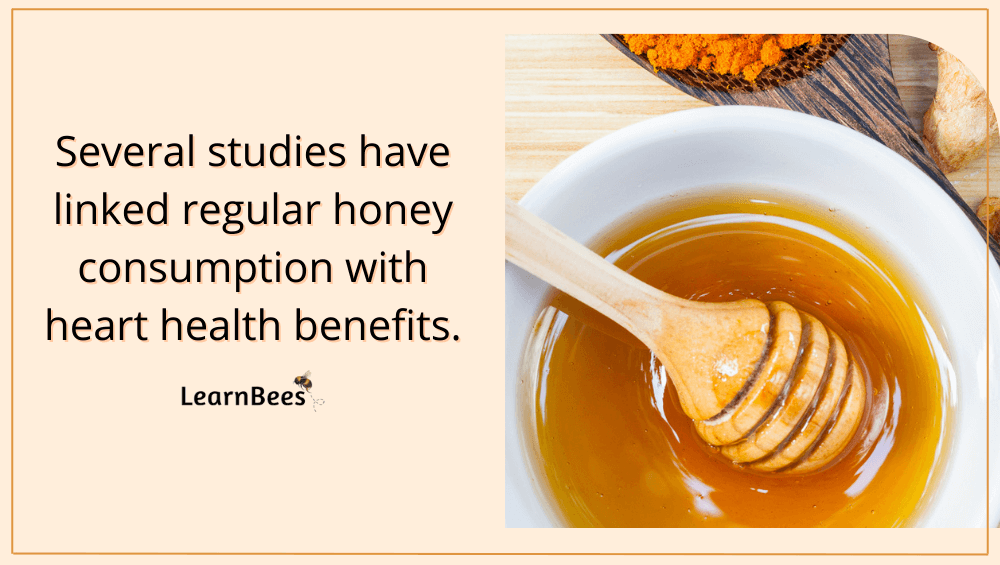
Did you know that high triglycerides are a risk factor for heart disease?
High blood triglycerides levels are also associated with insulin resistance, which puts people at risk for developing type 2 diabetes.(25, 26)
But now, here’s the interesting part:
Several studies have linked regular honey consumption with lower triglyceride levels. This is especially true when honey is used as a sugar substitute.(27, 28, 29, 30)
For example:
One study comparing sugar and honey found 11–19% lower triglyceride levels in the honey group.(31)
High LDL cholesterol levels also play a key factor in atherosclerosis. Atherosclerosis is the fatty buildup in your arteries that can cause heart attacks and strokes.(32, 33, 34)
Honey has been shown to decrease “bad” LDL cholesterol while significantly increasing “good” HDL cholesterol levels.
In fact, one study comparing honey and table sugar found that honey caused a 5.8% reduction in LDL cholesterol. It also led to a modest weight loss of 1.3%.(35, 36, 37, 38, 39)
And finally?
A study in rats showed that honey protected the heart from oxidative stress.(40)
Wildflower Honey Compared to Other Honey Types
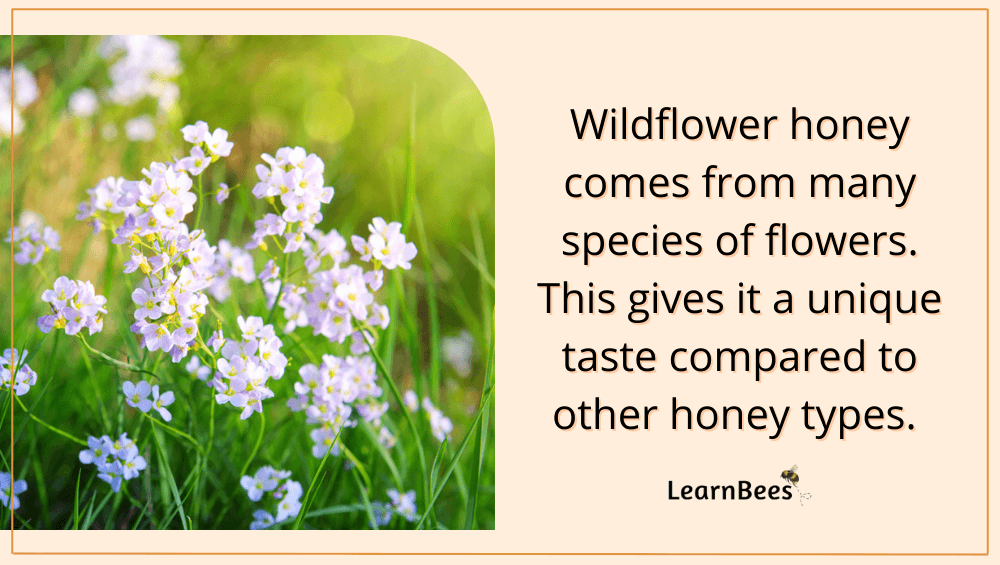
- Wildflower honey – is a type of honey made from a mix of wildflowers. Its flavor and strength depend on the season and the types of wildflowers the honeybees pollinate. Quality wildflower honey is raw and unfiltered, with a light, fruity taste.
- Clover honey – is a monofloral honey that comes predominantly from the nectar of clover plants. It’s typically light in color with a sweet, flowery flavor.
- Manuka honey – is a monofloral honey that comes predominately from manuka trees. Manuka honey offers several scientifically-backed health benefits. The taste is earthy, slightly nutty, and not as sweet as other honey types.
FAQs About Wildflower Honey
- Is wildflower honey the same as regular honey?
- What’s the wildflower honey color like?
- Is wildflower honey healthy?
- Why is it called wildflower honey?
- Which is better wildflower honey or clover honey?
- Does wildflower honey go bad?
- Is wildflower honey antiviral?
- Can you eat wildflower honey?
- Does wildflower honey taste different?
Is wildflower honey the same as regular honey?
People often ask, “Is wildflower honey better than regular honey?”
Here’s the thing:
There are more than 300 unique types of honey in the United States alone. They range in color from dark honey to light honey.(41)
For instance, common honey types include:
This means the term “regular honey” is vague because it doesn’t refer to a specific honey type. That said, when people say “regular honey,” they most often mean the kind found at the grocery store. But grocery store honey isn’t always real honey.
What do I mean by that?
Well, in 2018, the FDA released guidelines on how to label honey properly. According to those guidelines, honey should be a single ingredient product.(42)
So when you look at the back of the label, you should see “honey” as the only ingredient. If it has additives like corn syrup or sugar, it isn’t considered real honey.
And to take it a step further?
The FDA also says that any honey that’s been ultra-filtered and no longer contains pollen is no longer considered real honey.(43)
—> Go back to the FAQs on wildflower honey
More to Explore:
What’s the wildflower honey color like?
The color of wildflower honey varies depending on the batch.
There are more than 6,000 wildflower species in the United States alone. So wildflower honey can range in color from light brown to very dark brown.(44)
Generally speaking, honey harvested in late summer and fall will be darker in color. It will also typically have a richer, stronger taste.
Spring and early summer honey batches are more likely to be lightly colored and flavored.
The bottom line?
No matter the season, wildflower honey is delicious. It’s definitely something you should put on your food bucket list.
—> Go back to the FAQs on wildflower honey
More to Explore:
Is wildflower honey healthy?
“Is wildflower honey good for you?” is a common question we get.
The answer?
Yes. Honey is packed full of incredible health and skin benefits. If you want to read more about them, click here.
But don’t forget:
Honey shouldn’t be given to babies under 12 months old. Honey can contain spores that lead to infant botulism. Infant botulism is a rare but serious gastrointestinal condition that causes muscle weakness, a weak cry, and trouble breathing.(45, 46, 47)
—> Go back to the FAQs on wildflower honey
More to Explore:
- Acacia Honey: The Taste, Health Benefits, & Risks
- Honey for Skin Benefits: Directions, Uses, & Risks
- What Are Honeycombs Make Of?
Why is it called wildflower honey?
Honey typically gets its name from the types of plants and flowers the bees pollinate.
For example, buckwheat honey comes from bees who pollinate buckwheat flowers. Clover honey comes from bees who pollinate clover flowers.
So, of course, wildflower honey comes from bees who pollinate wildflowers. Wildflowers are flowers that grow naturally in the wild. They aren’t intentionally planted or seeded.(48)
—> Go back to the FAQs on wildflower honey
More to Explore:
Which is better – wildflower honey or clover honey?
Both types have a similar flavor in terms of taste because they’re fruity and light.
That said, clover honey is generally milder in flavor than wildflower honey. And in my opinion, you can taste more of the floral hints in wildflower honey.
—> Go back to the FAQs on wildflower honey
More to Explore:
Does wildflower honey go bad?
Here’s something that might surprise you:
When stored properly, honey is the only food that doesn’t expire.
You read that right.
Honey has a long shelf life because it’s hygroscopic, which means it doesn’t contain much moisture in its natural state. Because there’s so little water, bacteria and other microorganisms don’t thrive.(49, 50)
Honey is also acidic. Its pH level ranges from 3.4 to 6.1. This high acidity means bacteria don’t have a chance to survive.(51)
So as long as your honey is properly sealed and stored in a dry place, it’ll never expire. This means you can pass a jar of wildflower honey down to your great-grandkids.
But you might be asking:
Why does honey crystallize?
Honey naturally settles and hardens over time. This is crystallization, but it doesn’t mean your honey has gone bad.
If your honey has crystallized, you just need to let it sit in hot water for 15-20 minutes. It’ll be as good as new again.
—> Go back to the FAQs on wildflower honey
More to Explore:
Is wildflower honey antiviral?
Yes, honey is known for being antiviral, antibacterial, and antifungal.(52)
That’s why honey is a good choice for wounds like burns and scratches. It reduces inflammation and calms the skin. Some doctors have even started recommending honey in clinical settings.(53, 54)
—> Go back to the FAQs on wildflower honey
More to Explore:
Can you eat wildflower honey?
Yes, wildflower honey is a delicious and nutritious sweetener that can be incorporated into various foods and beverages.
This type of honey contains many beneficial nutrients and antioxidants, making it an excellent choice for those looking to enjoy the health benefits of honey.
—> Go back to the FAQs on wildflower honey
More to Explore:
Does wildflower honey taste different?
Yes, wildflower tastes different from other types of honey. This is because it is made from nectar collected from various flowers rather than a single type of flower. As a result, wildflower honey has a distinct flavor that varies depending on the plants and flowers that produced the nectar.
